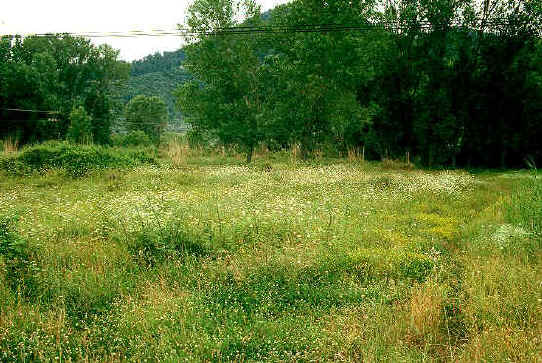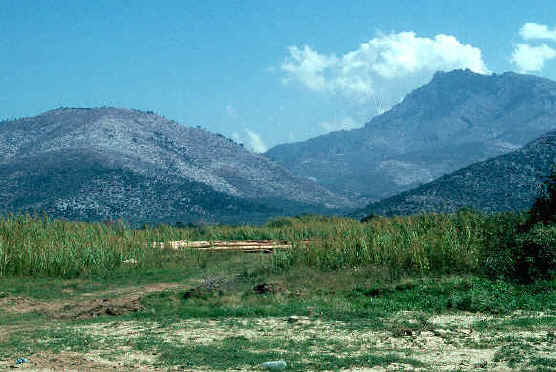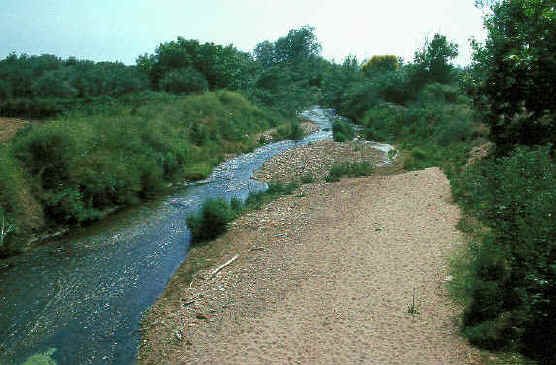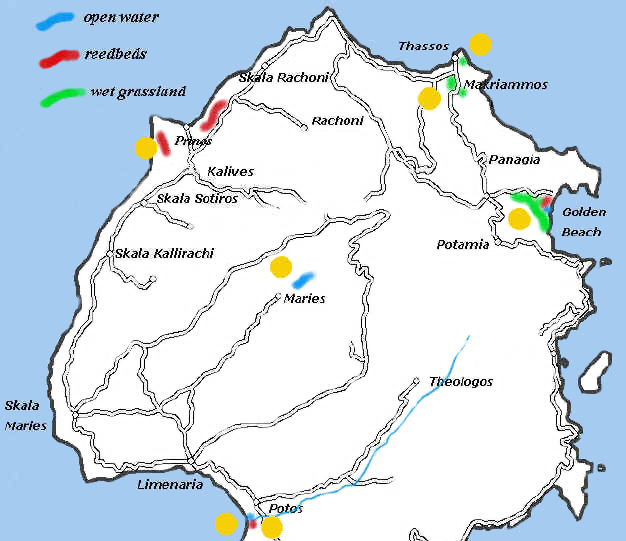______________________________________________________________________
WETLANDS
Wetland habitats are not extensive on Thásos, even by comparison with many
other Greek islands. Topography, geology and climate combine to produce a
generally dry landscape, such that the winter rains either percolate
 through the
limestone into underground aquifers or are rapidly shed from the mountain slopes
down swift-flowing rivers that almost reach the coast before slackening their
descent. The prevalence of low-key agriculture in the coastal flatlands means
that fertile soils here have been cultivated and any historic wetlands that may
have existed have largely been drained.
through the
limestone into underground aquifers or are rapidly shed from the mountain slopes
down swift-flowing rivers that almost reach the coast before slackening their
descent. The prevalence of low-key agriculture in the coastal flatlands means
that fertile soils here have been cultivated and any historic wetlands that may
have existed have largely been drained.
Few exceptions survive but these remnants contain important habitats for a
range of characteristic wildlife species and should be the focus of local
conservation efforts. Of prime importance is the area of damp sandy pastures on
the alluvial flats at Skala Potamia. Much of this has been drained and is
occupied by ancient olive groves or (more recently) maize, but towards the coast
there are numerous plots of wet, sedge-rich grassland and small reedbeds. These
pastures are botanically rich, snowflake Leucojum aestivum is a
speciality of the area, and the diverse flora supports an equally interesting
fauna, including a wealth of butterfly species. Through the pastures runs a
small sandy river and this is a
focus for the local birdlife as well as home to a distinctive assemblage of
invertebrates. Mole crickets (Gryllotalpa sp.) are abundant in the
friable soils of the river banks during early summer. Unfortunately development
continues apace at Skala Potamias-Golden Beach and the importance of the area is
steadily diminishing. The pasture depicted above, which was one of the most
botanically diverse, will soon be entirely destroyed as two new apartments
are being constructed on it in 2003. [By 2013 only small fragments of these
coastal meadows remained at Skala Potamia, many having been built over and
others scrubbed over due to a lack of grazing]
Similar damp pastures are highly localised elsewhere on the island. A good example on the outskirts of Thassos Town, on the SE side of the junction
with the Makriammos turn-off on the road to Panagia, which was botanically
diverse, was damaged by building works in 2003 and became more rank
and less species-rich through lack of grazing. Subsequently the area was
ploughed and built over. Across the road from here (behind
the Shell garage) Lance Chilton has discovered an extensive area of sedge rich
valley fen interspersed with unimproved damp pastures and poplar scrub. The
wetland stretches have an abundance of great horsetail Equisetum telmateia and
sparse reed and further exploration is likely to show that this is an important
area for the conservation of wetland plants and animals on Thásos. For
instance, recent surveys have found three whorl snail Vertigo species here
new to Thásos, including V. angustior and V. moulinsiana. Both of
these Vertigo species are rare throughout Europe and are included on
Annex II of the EC Habitats & Species Directive. Conservation measures
(presumably including the notification of a Special Area of Conservation) are
urgently required before this site is irreparably damaged by the tipping of
marble quarry spoil. One site whose future is guaranteed because of its past
is the Agora in Thassos Town. Loose-flowered orchids Orchis laxiflora are
common amongst the lush damp grassland around the ruins and water flows
throughout the year in the narrow ditches that cross the floor. Municipal
necessities dictate that the grassland is mown frequently but if you are
fortunate to visit just before cutting then the lushness and diversity is
striking by comparison with the parched pastures so typical of the island in
summer.
 On the
north-east coast of the island, seaward of the road between Rachoni and Prinos,
the surviving wet grasslands appear to be impoverished and most consist of
rather dry, sparse reedbeds. Ditch systems within the reeds north of Prinos are
said to contain eels but further wildlife surveys would be welcome here to determine
how much of interest remains. One example behind the beach at Cap Prinos is
extensive but somewhat degraded.
On the
north-east coast of the island, seaward of the road between Rachoni and Prinos,
the surviving wet grasslands appear to be impoverished and most consist of
rather dry, sparse reedbeds. Ditch systems within the reeds north of Prinos are
said to contain eels but further wildlife surveys would be welcome here to determine
how much of interest remains. One example behind the beach at Cap Prinos is
extensive but somewhat degraded.
The only substantial water body on the island is Genna Lake (Fragma Marion), up
in the mountains behind Maries. This is a reservoir and does not have well-developed wetland vegetation on
its margins, merely a narrow band of reedmace Typha sp. along its
southern margin. However, as the only site of its kind on the island it presumably
supports a number of restricted species. There is a small permanent
pool (seemingly artificial) at the back of the beach at Skala Potamia which is
over-shaded by willows and contains stands of sedge. Other still water bodies
are scarce and temporary, though at both Skala Potamia and Potos, where rivers
meet the beach, there are small pools and
reedbeds which persist throughout the summer. Shallow pools do
occur around the coastal fringe in scattered localities, filled with frogspawn
in Spring, but these dry up in early summer and become inconspicuous.
 Whilst there
are several major river valleys draining off the mountains, particularly in the
south, they tend to dry out to dusty river beds by summer. The Dipotamos river,
east of Potos, is the most permanent (as far as I know) and has sandy margins
and reed-fringed banks. It supports dragonflies, such as the club-tailed
dragonfly Onychogomphus forcipatus, and has gravel shoals with typical
beetle communities. Higher in the mountains there are permanent springs and
streams, whilst favoured locations in the forests have sheltered glades which
can be a haven for wildlife, with birds and butterflies drinking at the stream
edges and a variety of dragonflies hawking for prey.
Whilst there
are several major river valleys draining off the mountains, particularly in the
south, they tend to dry out to dusty river beds by summer. The Dipotamos river,
east of Potos, is the most permanent (as far as I know) and has sandy margins
and reed-fringed banks. It supports dragonflies, such as the club-tailed
dragonfly Onychogomphus forcipatus, and has gravel shoals with typical
beetle communities. Higher in the mountains there are permanent springs and
streams, whilst favoured locations in the forests have sheltered glades which
can be a haven for wildlife, with birds and butterflies drinking at the stream
edges and a variety of dragonflies hawking for prey.
Most Mediterranean wildlife is, of course, adapted to cope with summer
drought but wetlands everywhere attract a concentration of interesting species.
The relative scarcity of wetland habitats on Thásos makes each and every one
particularly valuable and their presence should be respected and conserved. It
would be a worthwhile venture for any visiting naturalists to document and map
their occurrence.







 On the
north-east coast of the island, seaward of the road between Rachoni and Prinos,
the surviving wet grasslands appear to be impoverished and most consist of
rather dry, sparse reedbeds. Ditch systems within the reeds north of Prinos are
said to contain eels but further wildlife surveys would be welcome here to determine
how much of interest remains. One example behind the beach at Cap Prinos is
extensive but somewhat degraded.
On the
north-east coast of the island, seaward of the road between Rachoni and Prinos,
the surviving wet grasslands appear to be impoverished and most consist of
rather dry, sparse reedbeds. Ditch systems within the reeds north of Prinos are
said to contain eels but further wildlife surveys would be welcome here to determine
how much of interest remains. One example behind the beach at Cap Prinos is
extensive but somewhat degraded. Whilst there
are several major river valleys draining off the mountains, particularly in the
south, they tend to dry out to dusty river beds by summer. The Dipotamos river,
east of Potos, is the most permanent (as far as I know) and has sandy margins
and reed-fringed banks. It supports dragonflies, such as the club-tailed
dragonfly Onychogomphus forcipatus, and has gravel shoals with typical
beetle communities. Higher in the mountains there are permanent springs and
streams, whilst favoured locations in the forests have sheltered glades which
can be a haven for wildlife, with birds and butterflies drinking at the stream
edges and a variety of dragonflies hawking for prey.
Whilst there
are several major river valleys draining off the mountains, particularly in the
south, they tend to dry out to dusty river beds by summer. The Dipotamos river,
east of Potos, is the most permanent (as far as I know) and has sandy margins
and reed-fringed banks. It supports dragonflies, such as the club-tailed
dragonfly Onychogomphus forcipatus, and has gravel shoals with typical
beetle communities. Higher in the mountains there are permanent springs and
streams, whilst favoured locations in the forests have sheltered glades which
can be a haven for wildlife, with birds and butterflies drinking at the stream
edges and a variety of dragonflies hawking for prey.